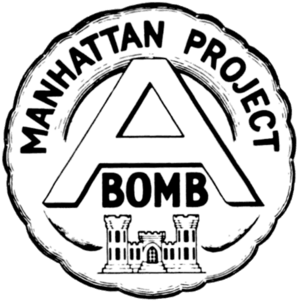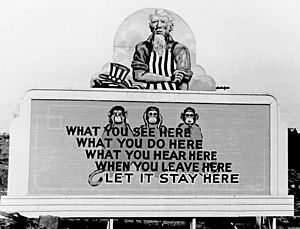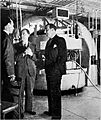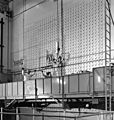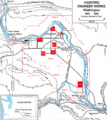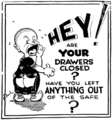Manhattan Project facts for kids
The Manhattan Project was the program based in the United States which tried to make the first nuclear weapons. The project went on during World War II, and was run by the U.S. Army. The head of the project was General Leslie R. Groves, who had led the building of the Pentagon. The top scientist on the project was Robert Oppenheimer, a famous physicist. The project cost $2 billion, and created many secret cities and bomb-making factories, such as a laboratory in Los Alamos, New Mexico, a nuclear reactor in Hanford, Washington, and a uranium processing plant in Oak Ridge, Tennessee.
The Manhattan Project had to find solutions to two difficulties. The first difficulty is how to make the special isotopes of uranium (uranium-235) or plutonium. This process is called separation and is very slow. The United States built very big buildings with three different kinds of machine for separation. They made enough fissionable special isotopes for a few nuclear weapons. The second difficulty was how to make a bomb that will produce a big nuclear explosion every time. A weapon with a bad design can make a much smaller nuclear explosion. This is called a "fizzle". In July 1945, the Manhattan Project solved the two difficulties and made the first nuclear explosion. This test of a nuclear weapon was called "Trinity" and was a success.
The Manhattan Project created two nuclear bombs which the United States used against Japan in 1945.
Espionage
The Manhattan Project operated under a blanket of tight security. This was to prevent the Axis countries, especially Nazi Germany, from accelerating their own nuclear projects or undertaking covert operations against the project. The possibility of sabotage was always present. At times, people suspected sabotage when equipment failed. While there were some problems believed to be the result of careless or disgruntled employees, there were no confirmed instances of Axis-instigated sabotage. However, on 10 March 1945, a Japanese fire balloon struck a power line, and the resulting power surge caused the three reactors at Hanford to be temporarily shut down.
Maintaining security was difficult because so many people worked on the project. A special Counter Intelligence Corps detachment handled the project's security issues. By 1943, it was clear that the Soviet Union was trying to penetrate the project. Lieutenant Colonel Boris T. Pash, the head of the Counter Intelligence Branch of the Western Defense Command, investigated suspected Soviet espionage at the Radiation Laboratory in Berkeley. Oppenheimer informed Pash that he had been approached by a fellow professor at Berkeley, Haakon Chevalier, about passing information to the Soviet Union.
The most successful Soviet spy was Klaus Fuchs. Fuchs was a member of the British Mission who played an important part at Los Alamos. The 1950 revelation of Fuchs' espionage activities damaged the United States' nuclear cooperation with Britain and Canada. Subsequently, other instances of espionage were uncovered, leading to the arrest of Harry Gold, David Greenglass and Ethel and Julius Rosenberg. Other spies like George Koval remained unknown for decades. People will never know the value of the espionage. One reason was that the Soviet atomic bomb project was held back by a shortage of uranium ore. The consensus is that espionage saved the Soviets one or two years of effort.
Images for kids
-
Enrico Fermi, John R. Dunning, and Dana P. Mitchell in front of the cyclotron in the basement of Pupin Hall at Columbia University
-
March 1940 meeting at Berkeley, California: Ernest O. Lawrence, Arthur H. Compton, Vannevar Bush, James B. Conant, Karl T. Compton, and Alfred L. Loomis
-
Oppenheimer and Groves at the remains of the Trinity test in September 1945, two months after the test blast and just after the end of World War II. The white overshoes prevented fallout from sticking to the soles of their shoes.
-
Groves confers with James Chadwick, the head of the British Mission.
-
Shift change at the Y-12 uranium enrichment facility at the Clinton Engineer Works in Oak Ridge, Tennessee, on 11 August 1945. By May 1945, 82,000 people were employed at the Clinton Engineer Works. Photograph by the Manhattan District photographer Ed Westcott.
-
Physicists at a Manhattan District-sponsored colloquium at the Los Alamos Laboratory on the Super in April 1946. In the front row are Norris Bradbury, John Manley, Enrico Fermi and J. (Jerome) M. B. Kellogg. Robert Oppenheimer, in dark coat, is behind Manley; to Oppenheimer's left is Richard Feynman. The Army officer on the left is Colonel Oliver Haywood.
-
The majority of the uranium used in the Manhattan Project came from the Shinkolobwe mine in Belgian Congo.
-
Aerial view of Hanford B-Reactor site, June 1944
-
The Trinity test of the Manhattan Project was the first detonation of a nuclear weapon.
-
Allied soldiers dismantle the German experimental nuclear reactor at Haigerloch.
-
Presentation of the Army–Navy "E" Award at Los Alamos on 16 October 1945. Standing, left to right: J. Robert Oppenheimer, unidentified, unidentified, Kenneth Nichols, Leslie Groves, Robert Gordon Sproul, William Sterling Parsons.
-
President Harry S. Truman signs the Atomic Energy Act of 1946, establishing the United States Atomic Energy Commission.
-
The Lake Ontario Ordnance Works (LOOW) near Niagara Falls became a principal repository for Manhattan Project waste for the Eastern United States. All of the radioactive materials stored at the LOOW site—including thorium, uranium, and the world's largest concentration of radium-226—were buried in an "Interim Waste Containment Structure" (in the foreground) in 1991.
-
After the reaction, the interior of a bomb coated with remnant slag
-
A uranium metal "biscuit" from the reduction reaction
See also
 In Spanish: Proyecto Manhattan para niños
In Spanish: Proyecto Manhattan para niños


